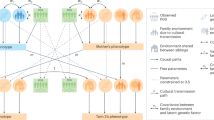Abstract
A review of recent studies of adult volunteer twins confirms an earlier report that, in such studies, male and dizygotic twin pairs are underre-presented. The Martin and Wilson [(1982). Behav. Genet.12:467–472] model of recruitment bias assumes that individuals who are twins respond to recruitment in the same way that singletons do. It is argued that twins recruited for twin studies may be influenced by additional factors, and evidence in support of this view is presented. The consequences of the augmented model. illustrated by Monte Carlo methods, suggests the following conclusions: (1) recruitment bias can have unpredictable and sometimes large effects in the form of under- or, more likely, overestimation of the true twin correlations; (2) these effects will tend to be larger among dizygotic, than among monozygotic, twins; and (3) differential recruitment bias is likely to be accompanied by monozygotic (MZ): dizygotic (DZ) differences in the total variance of the traits measured. Showing that the dependent variable has as large a variance in the twin sample as in the reference population, or that the means and variances of the MZ and DZ samples are similar, provides considerable reassurance that the sample statistics may be representative.
Similar content being viewed by others
References
Aitken, A. C. (1934). Notes on selection from a multivariate normal population.Proc. Edinburough Math. Soc. B 4:106–110.
Berg, K. (1984). Twin studies of coronary heart disease and its risk factors.Acta Genet. Med. Gemellol. 33:349–361.
Bulmer, M. G. (1970).The Biology of Twinning in Man, Clarendon Press, Oxford.
Chen, C. J., Cohen, B. H., Diamond, E. L., Lin, T. M., and Chen, J. S. (1984). Genetic variance and heritability of cardiovascular risk factors in Chinese adolescent twins.Acta Genet. Med. Gemellol. 33:364–370.
Clarke, P., Jardine, R., Martin, N. G., Stark, A. E., and Walsh, R. J. (1980). Sex differences in the inheritance of some anthropometric characters in twins.Acta Genet. Med. Gemellol. 29:171–192.
Cobb, M. J., Blizard, R. A., Fulker, D. W., and Murray, R. M. (1984). Preliminary findings from a study of the effects of a challenge dose of alcohol in male twins.Acta Genet. Med. Gemellol. 33:451–456.
Dal Colletto, G. M. D., Krieger, H., and Magalhaes, J. R. (1983). Genetic and environmental determination of 17 Serum biochemical traits in Brazilian twins.Acta Genet. Med. Gemellol. 32:23–29.
Darlu, P., Michotte, Y., Defrise-Gussenhoven, E., and Henrotte, J. (1981). The inheritance of plasma and red blood cell magnesium and zinc levels studied from twin and Family data.Acta Genet. Med. Gemellol. 30:67–75.
Eaves, L. J., Last, K. A., Young, P. A., and Martin, N. G. (1978). Model-fitting approaches to the analysis of human behavior.Heredity 41:249–320.
Hemon, D., Berger, C., and Lazar, P. (1981). Some observations concerning the decline of dizygotic twinning rate in France between 1901 and 1968.Twin Res. 3C:49–56.
James, W. H. (1972). Secular changes in dizygotic twinning rates.J. Biosoc. Sci. 4:427–434.
James, W. H. (1979). Is Weinberg's differential rule valid?Acta Genet. Med. Gemellol. 28:69–71.
Jardine, R., and Martin, N. G. (1984). Causes of variation in drinking habits in a large twin sample.Acta Genet. Med. Gemellol. 33:435–450.
Jeanneret, O., and MacMahon, B. (1962). Secular changes in rates of multiple births in the United States.Am. J. Hum. Genet. 14:410–465.
Johnson, N. L., and Kotz, S. (1969).Continuous Univariate Distributions. I, John Wiley & Sons, New York.
Kaprio, J., Sarna, S., Koskenvuo, M., and Rantasalo, I. (1978). The Finnish twin registry: Formation and compilation, questionnaire study, zygosity determination procedures, and research program. In Gedda, L., Parisi, P., and Nance, W. E. (eds.),Twin Research: Biology and Epidemiology, Alan R. Liss, New York, pp. 179–184.
Lykken, D. T., Tellegen, A., and DeRubeis, R. (1978). Volunteer bias in twin research: The rule of two-thirds.Soc. Biol. 25:1–9.
Martin, N. G., and Wilson, S. R. (1982). Bias in the estimation of heritability from truncated samples of twins.Behav. Genet. 12:467–472.
Medlund, P., Cederlof, R., Floderus-Myrhed, B., Friberg, L., and Sorensen, S. (1977). A new Swedish twin registry.Acta Med. Scand. Suppl. 600.
Mendell, N. R., and Elston, R. C. (1974). Multifactorial qualitative traits: Genetic analysis of prediction of recurrence risks.Biometrics 30:41–57.
Milner, J., Christian, J. C., and Hewitt, D. (1980). Plasma lipid variability in the Toronto Twin Register.Acta Genet. Med. Gemellol. 29:299–302.
Rice, J., Reich, T., and Cloninger, C. R. (1979). An approximation to the multivariate normal integral: Its application to multifactorial qualitative traits.Biometrics 35:451–459.
Rosenthal, R., and Rosnow, R. L. (1975).The Volunteer Subject, Wiley-Interscience, New York.
Rushton, J. P., Fulker, D. W., Neale, M. C., Blizard, R. A., and Eysenck, H. J. (1984). Altruism and genetics.Acta Genet. Med. Gemellol. 33:265–271.
Springer, S. P., and Searleman, A. (1978). The ontogeny of hemispheric specialization: Evidence from dichotic listening in twins.Neuropsychologia 16:269–281.
Susanne, C., Defrise-Gussenhoven, E., Van Wanseele, P., and Tassin, A. (1983). Genetic and environmental factors in head and face measurements of Belgian twins.Acta Genet. Med. Gemellol. 32:229–238.
Torgersen, S. (1980). Hereditary-environmental differentiation of general neurotic, obsessive, and impulsive hysterical personality types.Acta Genet. Med. Gemellol. 29:193–207.
Author information
Authors and Affiliations
Additional information
This work was supported in part by Grant MH37860 from the National Institute of Mental Health.
Rights and permissions
About this article
Cite this article
Lykken, D.T., McGue, M. & Tellegen, A. Recruitment bias in twin research: The rule of two-thirds reconsidered. Behav Genet 17, 343–362 (1987). https://doi.org/10.1007/BF01068136
Received:
Accepted:
Issue Date:
DOI: https://doi.org/10.1007/BF01068136




